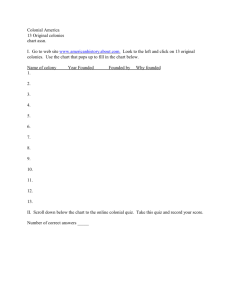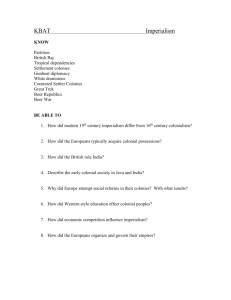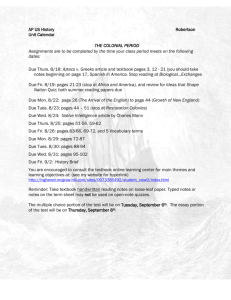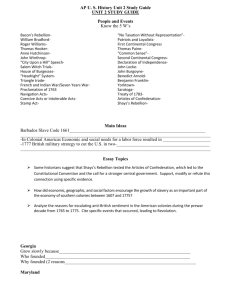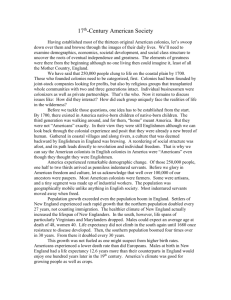IV. Single-Answer Multiple Choice. Mark the one best answer for
advertisement
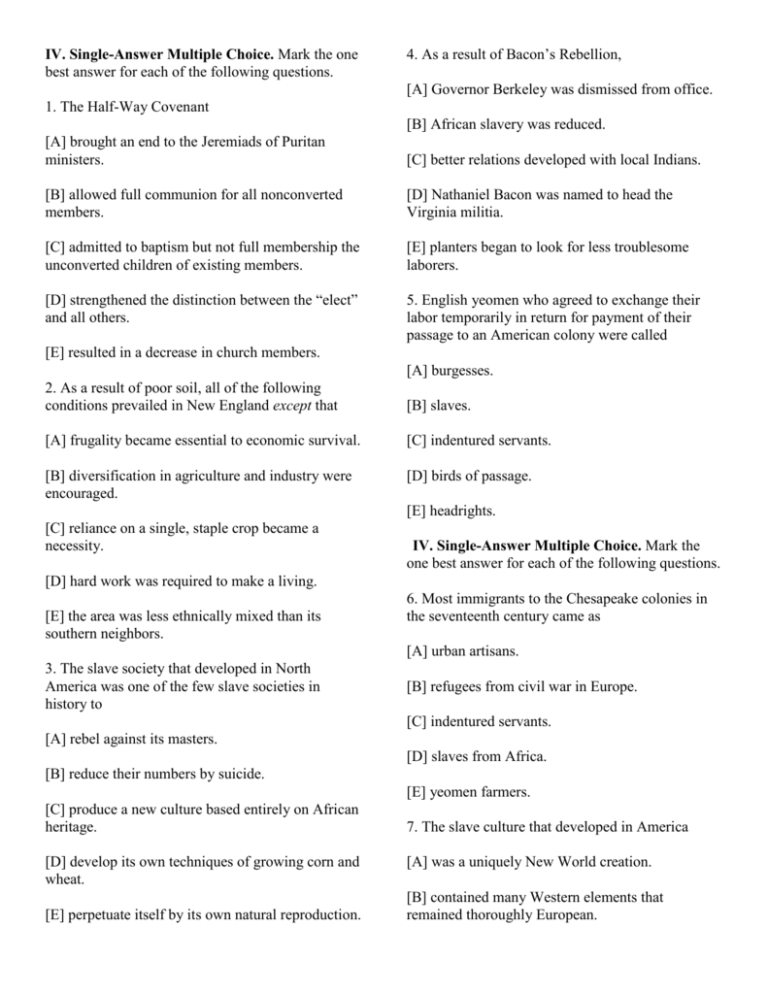
IV. Single-Answer Multiple Choice. Mark the one best answer for each of the following questions. 4. As a result of Bacon’s Rebellion, [A] Governor Berkeley was dismissed from office. 1. The Half-Way Covenant [B] African slavery was reduced. [A] brought an end to the Jeremiads of Puritan ministers. [C] better relations developed with local Indians. [B] allowed full communion for all nonconverted members. [D] Nathaniel Bacon was named to head the Virginia militia. [C] admitted to baptism but not full membership the unconverted children of existing members. [E] planters began to look for less troublesome laborers. [D] strengthened the distinction between the “elect” and all others. 5. English yeomen who agreed to exchange their labor temporarily in return for payment of their passage to an American colony were called [E] resulted in a decrease in church members. [A] burgesses. 2. As a result of poor soil, all of the following conditions prevailed in New England except that [B] slaves. [A] frugality became essential to economic survival. [C] indentured servants. [B] diversification in agriculture and industry were encouraged. [D] birds of passage. [E] headrights. [C] reliance on a single, staple crop became a necessity. IV. Single-Answer Multiple Choice. Mark the one best answer for each of the following questions. [D] hard work was required to make a living. [E] the area was less ethnically mixed than its southern neighbors. 6. Most immigrants to the Chesapeake colonies in the seventeenth century came as [A] urban artisans. 3. The slave society that developed in North America was one of the few slave societies in history to [B] refugees from civil war in Europe. [C] indentured servants. [A] rebel against its masters. [D] slaves from Africa. [B] reduce their numbers by suicide. [E] yeomen farmers. [C] produce a new culture based entirely on African heritage. [D] develop its own techniques of growing corn and wheat. [E] perpetuate itself by its own natural reproduction. 7. The slave culture that developed in America [A] was a uniquely New World creation. [B] contained many Western elements that remained thoroughly European. [C] was Muslim in its religious teachings. 11. It was typical of colonial New England adults to [D] was derived exclusively from African roots. [A] be unable to read and write. [E] rejected Christianity. [B] live alone. 8. As the seventeenth century wore on, regional differences arose, most notably [C] die before becoming grandparents. [D] marry early and have several children. [A] slave labor. [E] arrive in New England unmarried. [B] the continuing rigidity of Puritanism. [C] the breaking of the Atlanta economy. 12. By 1700, the most populous colony in English America was [D] loyalty to England. [A] New York. [E] the use of indentured servants. [B] Massachusetts. 9. In contrast to the Chesapeake colonies, those in New England [C] Virginia. [D] Pennsylvania. [A] followed the land use pattern established by the local Indians. [E] Maryland. [B] had a more diversified economy. 13. Bacon’s Rebellion was supported mainly by [C] had a more ethnically mixed population. [A] young men frustrated by their inability to acquire land. [D] were more oriented toward the individual than toward community interests. [B] the local Indians. [E] expanded westward in a less orderly fashion. [C] the planter class of Virginia. 10. Throughout the greater part of the seventeenth century, the Chesapeake colonies acquired most of the labor they needed from [D] those protesting the increased importation of African slaves. [E] people from Jamestown only. [A] African slaves. 14. The expansion of New England society [B] captured Indians. [C] white servants. [D] prisoners of war. [A] took place without the approval of the colonial legislature. [B] was undertaken by lone-wolf farmers on their own initiative. [E] West Indian natives. [C] was a rather haphazard process. IV. Single-Answer Multiple Choice. Mark the one best answer for each of the following questions. [D] led to little concern about the community as a whole. [E] proceeded in an orderly fashion. [A] energy. 15. Compared with most seventeenth-century Europeans, Americans lived in [B] self-reliance. [C] stubbornness. [A] a more rigid class system. [D] resourcefulness. [B] affluent abundance. [E] all of these. [C] more primitive circumstances. [D] relative poverty. 19. The English justified taking land from the native inhabitants on the grounds that the Indians [E] larger cities. [A] burned woodlands. IV. Single-Answer Multiple Choice. Mark the one best answer for each of the following questions. [B] refused to sell it. [C] were not Christians. 16. Seventeenth-century colonial tobacco growers usually responded to depressed prices for their crop by [D] wasted the earth by underutilizing its bounty. [E] all of these. [A] selling land to reduce their volume of production. [B] releasing unneeded indentured servants early. 20. The Salem “witch hunt” in 1692 [A] was ultimately of little consequence for those who were accused of witchcraft. [C] planting corn and wheat instead of tobacco. [B] was the largest “witch hunt” in recorded history. [D] growing more tobacco to increase their volume of production. [C] did not see anyone put to death. [E] selling slaves to reduce productive labor. [D] was the first in the English American colonies. 17. Most of the inhabitants of the colonial American South were [E] was opposed by the more responsible members of the clergy. [A] black slaves. IV. Single-Answer Multiple Choice. Mark the one best answer for each of the following questions. [B] landless farm laborers. [C] merchant planters. 21. In seventeenth century colonial America all of the following are true regarding women except [D] native Americans. [A] abusive husbands were punished. [E] landowning small farmers. [B] women had no rights as individuals. 18. The combination of Calvinism, soil, and climate in New England resulted in the people there possessing which of the following qualities: [C] a husband’s power over his wife was not absolute. [D] women were regarded as morally weaker than men. [A] race was rarely an issue in relations between blacks and whites. [E] women could not vote. [B] profit soon played a very small role. 22. Thomas Jefferson once observed that “the best school of political liberty the world ever saw” was the [C] racial discrimination also powerfully molded the American slave system. [A] Chesapeake plantation system. [D] Europe profited most from the institution. [B] New England town meeting. [E] it soon became clear by 1700 that profits were down. [C] College of William and Mary. [D] the English parliament. [E] Virginia House of Burgesses. IV. Single-Answer Multiple Choice. Mark the one best answer for each of the following questions. 26. By 1775, the __________ were the largest non-English ethnic group in colonial America. 23. The New England economy depended heavily on [A] Africans [A] slave labor. [B] Germans [B] fishing, shipbuilding, and commerce. [C] Scots-Irish [C] tobacco. [D] Irish [D] the production of many staple crops. [E] West Indians [E] all of these. 27. The most important economic enterprise in the American colonies was 24. The “headright” system, which made some people very wealthy, entailed [A] manufacturing. [A] giving a father’s wealth to the oldest son. [B] fishing. [B] giving the right to acquire fifty acres of land to the person paying the passage of a laborer to America. [C] agriculture. [C] using Indians as forced labor. [E] slave trading. [D] giving land to indentured servants to get them to come to the New World. 28. The triangular trade of the colonial American shipping industry [E] discouraging the importation of indentured servants to America. [A] saw the Spanish gaining the largest profits. [D] commerce. [B] involved America, France, and England. 25. While slavery might have begun in America for economic reasons, [C] was not that profitable. [A] of the religious impact of the Puritans. [D] involved the trading of rum for African slaves. [B] of peacetime economic developments. [E] relied on the Spanish fleet for protection. 29. The population growth of the American colonies by 1775 is attributed mostly to [C] fewer yeoman farmers were arriving from Europe. [A] the natural fertility of Native Americans. [D] some merchants made huge profits as military suppliers. [B] the influx of immigrants from Latin America. [E] of the increase in the slave trade. [C] white immigration from Europe. 33. In colonial elections, [D] the natural fertility of all Americans. [A] the right to vote was reserved for property holders. [E] the importation of slaves from Africa. [B] average citizens were usually elected to office. 30. The average age of the American colonists in 1775 was [C] most eligible voters zealously exercised their right to vote. [A] 16. [D] true democracy had arrived. [B] 30. [E] only a small landed elite had the right to vote. [C] 25. [D] 20. 34. By 1775, most governors of American colonies were [E] 40. [A] appointed by the British Parliament. IV. Single-Answer Multiple Choice. Mark the one best answer for each of the following questions. [B] appointed by the king. [C] elected by popular vote. 31. The most ethnically diverse region of colonial America was __________, whereas __________ was the least ethnically diverse. [D] appointed by colonial proprietors. [E] elected by the vote of colonial legislatures. [A] the middle colonies, New England [B] the middle colonies, the South 35. In 1775, the __________ churches were the only two established (tax-supported) churches in colonial America. [C] the frontier regions, New England [A] Quaker and Catholic [D] the South, New England [B] Congregational and Anglican [E] New England, the South [C] Presbyterian and Anglican 32. On the eve of the American Revolution, social and economic mobility decreased, partly because [D] Presbyterian and Congregational [E] Methodist and Anglican IV. Single-Answer Multiple Choice. Mark the one best answer for each of the following questions. [A] such an action brought in more money to England. [B] the American colonists supported such a move. 36. One outstanding feature common to all of the eventually rebellious colonies was their [C] they were concerned about the eternal souls of the colonists. [A] support of religious freedom. [B] economic organization. [C] rapidly growing populations. [D] such an action would restore enthusiasm for religion. [E] the church would act as a major prop for kingly authority. [D] relatively equal wealth. [E] similar social structures. 37. In colonial America, education was most zealously promoted IV. Single-Answer Multiple Choice. Mark the one best answer for each of the following questions. 40. The time-honored English ideal, which Americans accepted for some time, regarded education as [A] in the South. [A] reserved for the aristocratic few. [B] on the frontier. [B] unimportant for leaders. [C] in New England. [C] essential training for citizenship. [D] in those areas controlled by Spain. [D] designed for men and women. [E] in the middle colonies. [E] designed for rich and poor alike. 38. As a result of the rapid population growth in colonial America during the eighteenth century, 41. The most honored profession in early colonial society was [A] the need for slave labor declined. [A] medicine. [B] a momentous shift occurred in the balance of power between the colonies and the mother country. [C] the colonists became more dependent on Britain for the goods that they needed to survive. [B] the ministry. [C] farming. [D] merchants. [D] the British government was pleased that more workers would be available to fill an increasing need for laborers in Britain. [E] the British government granted greater autonomy to colonial governments. 39. English officials tried to “establish” the Church of England in as many colonies as possible because [E] law. 42. When several colonial legislatures attempted to restrict or halt the importation of slaves, British authorities [A] viewed such colonial actions as morally callous. [B] allowed only South Carolina’s legislation to stand. [D] perhaps the most diverse in the world, although it remained predominantly Anglo-Saxon. [C] did nothing. [E] none of these. [D] vetoed such efforts. [E] applauded the efforts. 46. When the Scots-Irish established a new community, one of the first tasks they undertook was to 43. During the colonial era, all of the following peoples created new societies out of diverse ethnic groups in America except [A] establish a court. [B] make peace with local Indians. [A] Asians. [C] institute a theocracy. [B] English. [D] build a tavern. [C] Africans. [E] erect a church. [D] French. [E] Indians. 44. The religious doctrine of the Armenians held that 47. Colonial American taverns were all of the following except [A] another cradle of democracy. [B] frequented mainly by the lower class. [A] Calvin’s ideas should be followed without question. [C] important in crystallizing public opinion. [B] predestination determined a person’s eternal fate. [D] hotbeds of agitation for the Revolutionary movement. [C] good works could get you into heaven. [E] places providing amusements. [D] individual free will determined a person’s eternal fate. 48. The major manufacturing enterprise in colonial America in the eighteenth century was [E] emotion had no place in religion. [A] making clothes. IV. Single-Answer Multiple Choice. Mark the one best answer for each of the following questions. [B] arms and munitions production. [C] rum distilling. 45. The population of the thirteen American colonies was [D] iron making. [A] most ethnically mixed in New England. [E] lumbering. [B] about one-half non-English. 49. American colonists sought trade with countries other than Great Britain [C] about evenly divided among Anglo-Saxons, French, Scots-Irish, and Germans. [A] to make money to buy what they wanted in Britain. [B] to help strengthen the French. [C] to anger Parliament. [D] mainly to anger the king. [E] in order to gain their independence. IV. Single-Answer Multiple Choice. Mark the one best answer for each of the following questions. 50. Which of the following was not considered to be a naval store? [A] rosin [B] tar [C] turpentine [D] glass [E] pitch




